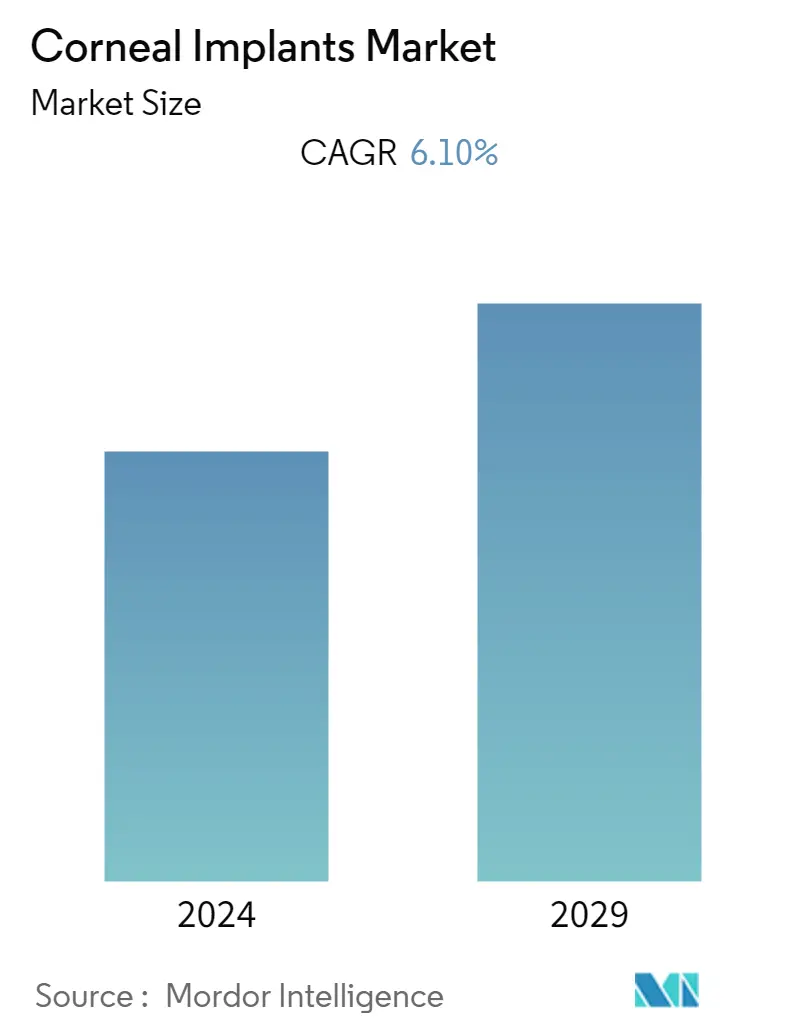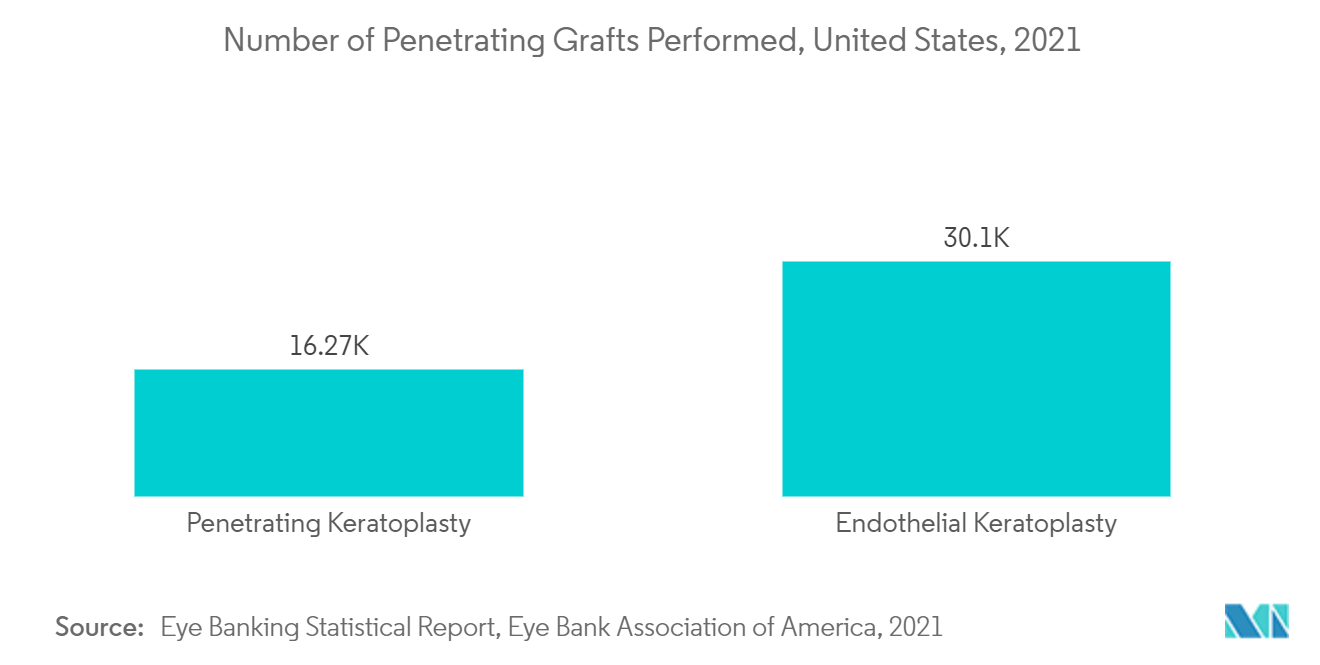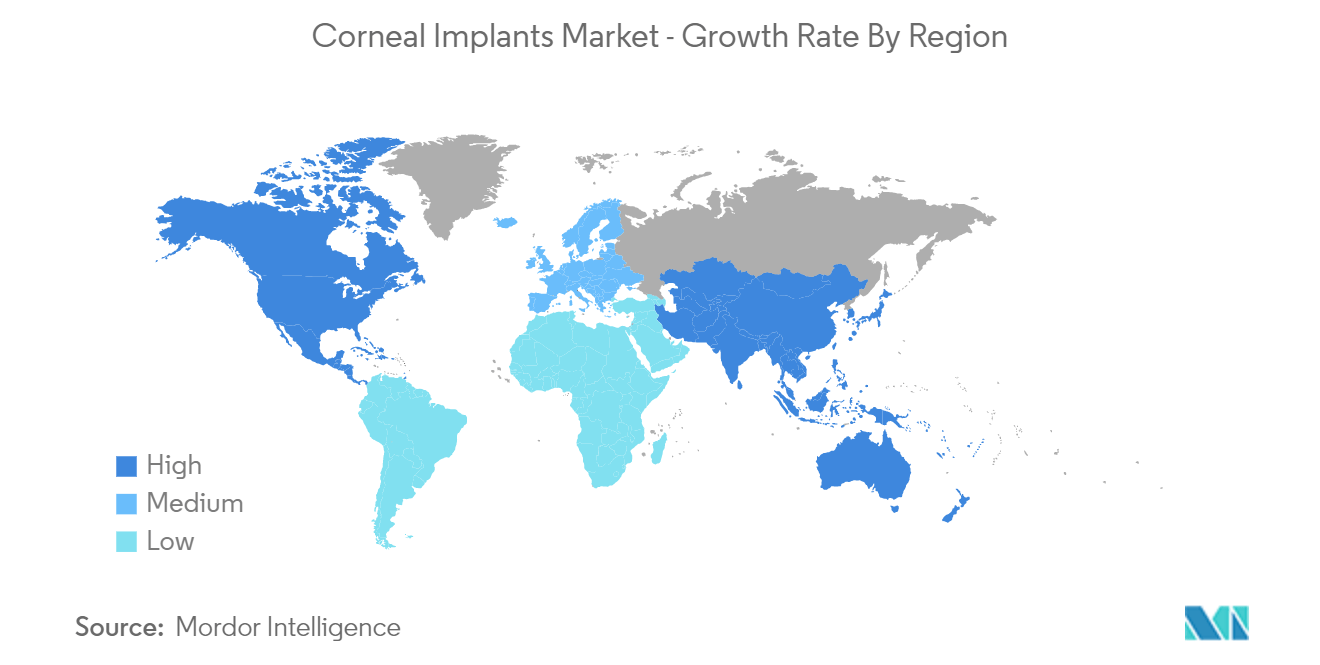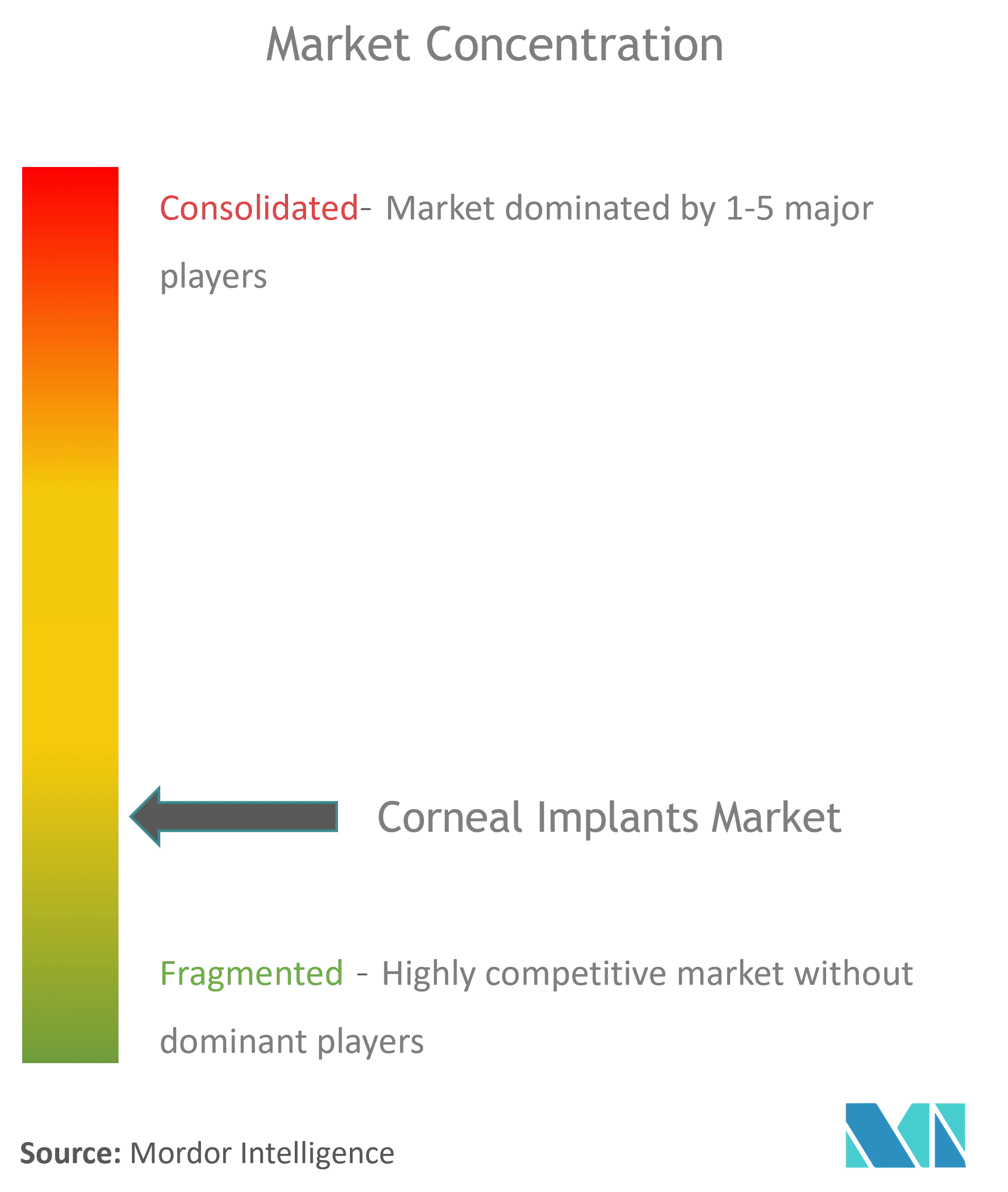Corneal Implants Market Size

| Study Period | 2019 - 2029 |
| Base Year For Estimation | 2023 |
| CAGR | 6.10 % |
| Fastest Growing Market | Asia-Pacific |
| Largest Market | North America |
| Market Concentration | Medium |
Major Players
*Disclaimer: Major Players sorted in no particular order |
Corneal Implants Market Analysis
The corneal implants market is projected to register a CAGR of 6.1% during the forecast period.
The rapid emergence of the COVID-19 pandemic has had a significant impact on ophthalmic surgery across the globe. The suspension of elective procedures during the pandemic reduced the number of patients undergoing ophthalmic surgery globally, as ophthalmic procedures are considered elective procedures. Also, in March 2020, CMS recommended the cancellation of elective surgery as part of the national response to COVID-19. Moreover, in March 2020, the AAO released practice guidelines advising ophthalmologists to cease providing any treatment other than urgent and emergent care. Moreover, as per August 2021 published by the International Journal of Environmental Research and Public Health, no rebound effect was observed once the pandemic restrictions were eased. Simultaneous bilateral cataract surgeries (SBCS) constituted 6.5% of cataract procedures performed in April 2021 and May 2021 compared with 0.77% carried out between May 2019 and March 2021. Hence, the COVID-19 pandemic impacted the market at the initial stages of the pandemic but then started to cover significantly as the COVID-19 cases started to subside.
The market growth can be largely attributed to the factors such as technological advancements in corneal implants, the increasing prevalence of the geriatric population, and growing incidences of eye disorders worldwide. These factors are leading to a huge demand for corneal implants in healthcare facilities. The geriatric population is prone to suffer from Fuchs' dystrophy which is treated with endothelial keratoplasty (EK). According to a March 2020 article published in Progress in Retinal and Eye Research, the late-onset form of Fuchs' endothelial dystrophy is a common condition, affecting approximately 4% of people above 40 years of age in the United States. In addition, bullous keratopathy is the most common condition among older people who undergo cataract surgery. Such patients are recommended to undergo an EK procedure. Moreover, as per the World Population Ageing 2022 report by the UN, the share of the global population aged 65 years or above is projected to rise from 10% in 2022 to 16% in 2050. By 2050, the number of persons aged 65 years or over worldwide is projected to be more than twice the number of children under age 5 and about the same as the number of children under age 12. Thus, the increase in the geriatric population will fuel overall market growth.
Moreover, the demand for collagen-based artificial corneas is increasing owing to their biocompatibility and low cost which has led to the development of bio-engineered artificial corneas. In addition, increased R&D activities in this area are contributing to market growth. For instance, in July 2020, CorNeat Vision developed an easily implantable and affordable artificial cornea, CorNeat KPro. The CorNeat KPro has been designed to replace scarred, deformed, or opacified corneas and is anticipated to fully and immediately rehabilitate the vision of corneally blind patients. The product is expected to achieve CE marking and US FDA clearance in 2022. Also, in June 2021, Israeli ophthalmology startup, EyeOn Medical, received a CE Mark for its flagship product EndoArt, the world's first synthetic corneal implant designed to counteract corneal edema. Thus, the aforementioned technological developments are contributing to the rising demand for corneal implants.
Also, due to the growing incidence of eye disorders worldwide, there is a huge demand for corneal implants. Corneal implants are used in the treatment of keratoconus, corneal opacity, corneal blindness, and other eye disorders. As per the 2020 statistics by the Cornea Research Foundation of America, 50 to 200 out of every 100,000 people in the general population were affected by keratoconus disorder in 2020. This indicates that an increase in several people suffering from keratoconus disorder is expected to increase the demand for corneal implants. In addition, as per the 2020 statistics by the RNIB, an estimated number of 4.1 million people in the United Kingdom will be affected by blindness by 2050. Furthermore, as per the WHO statistics of 2021, globally, approximately 2.2 billion people had near or distant vision impairment and 4.2 million people had corneal opacities in 2020. Such a huge number indicates a high demand for corneal implants. Thus, all the above-mentioned factors are currently augmenting the growth of the corneal implant market.
However, the high costs of surgical procedures and ophthalmic devices and the availability of alternative treatments are some of the factors impeding the market growth.
Corneal Implants Market Trends
This section covers the major market trends shaping the Corneal Implants Market according to our research experts:
Penetrating Keratoplasty is Expected to Witness a Significant Growth During the Forecast Period
The major factors attributed to the growth of invasive keratoplasty are the increasing number of people suffering from eye-ball injuries and eye disorders. Penetrating keratoplasty procedures are performed to treat patients suffering from eye disorders such as corneal ulcers and infectious keratitis. In addition, penetrating keratoplasty (PKP) is preferred for treating ectatic corneal disease and has been the standard procedure for the treatment of keratoconus patients with remarkable optical and visual outcomes for keratoconus patients that are contact lens intolerant or have corrected visual acuity.
Moreover, an increasing number of penetrating keratoplasty procedures indicates the rising demand for corneal implants. According to the 2021 Eye Banking Statistical Report by the EBAA, the total number of United States-supplied tissue distributed for keratoplasty (including long-term preserved tissue) was 79,641, a 20.2% increase from 66,278 in 2020. 49,110 intermediate-term preserved corneas were transplanted in the United States, and 22,928 were exported internationally in 2021. As per the same source, the number of penetrating keratoplasty (PK) grafts in the United States was 16,269 (a 5.6% increase), while EK numbers increased by 15.3% to 30,098. Hence, the increasing number of penetrating keratoplasty surgeries indicates the rising demand for corneal implants. Thus, given the above-mentioned factors, the segment is anticipated to grow significantly during the forecast period.

North America Accounted for the Largest Share in the Global Market
Within North America, the United States has held the major share of the market and is expected to dominate during the forecast period. The increasing awareness about eye donation in the region and the presence of several organizations are a few of the major factors accounting for the growth of the market in the region. For instance, the EBAA celebrates eye donation month each November to raise awareness about cornea donation and transplantation. Such initiatives are likely to increase the number of eye surgeries performed in the country.
Additionally, the increasing prevalence of keratoconus is expected to increase the demand for corneal implants, which is expected to boost the growth of the market during the forecast period. For instance, according to the EBAA 2021 report, keratoconus affects one in every 2,000 Americans. It generally manifests early in life and is most prevalent among teenagers and adults. This is likely to create demand for the product.
Moreover, as per the June 2020 statistics by the CDC, approximately 12 million people aged 40 years and above suffered from vision impairment in the United States in 2020. Thus, the high prevalence of vision impairment in the region has boosted the number of ophthalmic surgeries that further contribute to the rising demand for corneal implants.
Thus, all the aforementioned factors are expected to boost the market in the region during the forecast period.

Corneal Implants Industry Overview
The corneal implants market is highly fragmented due to the presence of several regional and global market players. These players focus on growth strategies such as new product launches, innovations in existing products, and mergers and acquisitions. Some of the market players are also focusing on the provision of human eye corneas while maintaining a focus on eye donations. Key players operating in the global market are CorneaGen, CorNeat Vision, Aurolab, KERAMED Inc., and Price Vision Group, among others.
Corneal Implants Market Leaders
-
CorneaGen
-
CorNeat Vision
-
Aurolab
-
Price Vision Group
-
KERAMED, INC.
*Disclaimer: Major Players sorted in no particular order

Corneal Implants Market News
- September 2022: Celregen and Cellusion Inc. signed an exclusive license agreement for corneal endothelial cell regenerative therapy in Greater China.
- July 2022: Carl Zeiss Meditec and Precise Bio announced a partnership in the development and commercialization of tissue-based implants for ophthalmology.
Corneal Implants Market Report - Table of Contents
1. INTRODUCTION
- 1.1 Study Assumptions and Market Definition
- 1.2 Scope of the Study
2. RESEARCH METHODOLOGY
3. EXECUTIVE SUMMARY
4. MARKET DYNAMICS
- 4.1 Market Overview
-
4.2 Market Drivers
- 4.2.1 Technological Advancements in Corneal Implants
- 4.2.2 Increasing Prevalence of Geriatric Population
- 4.2.3 Growing Incidences of Eye Disorders
-
4.3 Market Restraints
- 4.3.1 High Cost of Surgical Procedures and Ophthalmic Devices
- 4.3.2 Availability of Alternative Treatments
-
4.4 Porter's Five Force Analysis
- 4.4.1 Threat of New Entrants
- 4.4.2 Bargaining Power of Buyers/Consumers
- 4.4.3 Bargaining Power of Suppliers
- 4.4.4 Threat of Substitute Products
- 4.4.5 Intensity of Competitive Rivalry
5. MARKET SEGMENTATION (Market Size by Value - USD Million)
-
5.1 By Implant Type
- 5.1.1 Artificial Corneal Implant
- 5.1.2 Human Corneal Implant
-
5.2 By Procedure Type
- 5.2.1 Endothelial Kertoplasty
- 5.2.2 Penetrating Keratoplasty
- 5.2.3 Other Procedure Types
-
5.3 By Disease Indication
- 5.3.1 Keratoconus
- 5.3.2 Fuschs' Dystrophy
- 5.3.3 Infectious Keratitis
- 5.3.4 Corneal Ulcers
- 5.3.5 Other Disease Indications
-
5.4 By End User
- 5.4.1 Hospitals
- 5.4.2 Ambulatory Surgical Centers
- 5.4.3 Ophthalmic Centers
-
5.5 Geography
- 5.5.1 North America
- 5.5.1.1 United States
- 5.5.1.2 Canada
- 5.5.1.3 Mexico
- 5.5.2 Europe
- 5.5.2.1 Germany
- 5.5.2.2 United Kingdom
- 5.5.2.3 France
- 5.5.2.4 Italy
- 5.5.2.5 Spain
- 5.5.2.6 Rest of Europe
- 5.5.3 Asia-Pacific
- 5.5.3.1 China
- 5.5.3.2 Japan
- 5.5.3.3 India
- 5.5.3.4 Australia
- 5.5.3.5 South Korea
- 5.5.3.6 Rest of Asia-Pacific
- 5.5.4 Rest of the World
6. COMPETITIVE LANDSCAPE
-
6.1 Company Profiles
- 6.1.1 Florida Lions Eye Bank
- 6.1.2 CorNeat Vision
- 6.1.3 CorneaGen
- 6.1.4 San Diego Eye Bank
- 6.1.5 Alabama Eye Bank
- 6.1.6 Aurolab
- 6.1.7 Cornea Biosciences
- 6.1.8 KERAMED INC.
- 6.1.9 Price Vision Group
- 6.1.10 LinkoCare LifeSciences AB
- 6.1.11 Presbia PLC
- 6.1.12 AJL Ophthalmic SA
- 6.1.13 DIOPTEX
- 6.1.14 Massachusetts Eye and Ear
- *List Not Exhaustive
7. MARKET OPPORTUNITIES AND FUTURE TRENDS
** Subject To AvailablityCorneal Implants Industry Segmentation
The corneal implant is the incorporation of human donor cornea tissue or artificial cornea to replace the diseased cornea of the eye via anterior lamellar keratoplasty, endothelial keratoplasty, penetrating keratoplasty, keratoprosthesis, and keratoprosthesis. It is designed for long-term vision and is primarily used for the treatment of ophthalmic disorders such as Fuchs' dystrophy and keratoconus, among others.
The corneal implants market is segmented by type (human cornea and artificial cornea), procedure type (endothelial keratoplasty, penetrating keratoplasty, and other procedure types), disease indication (keratoconus, Fuchs dystrophy, infectious keratitis, corneal ulcers, and other disease indications), end user (hospitals, ambulatory surgical centers, and ophthalmic centers), and geography (North America, Europe, Asia-Pacific, and Rest of the World). The report offers the value (in USD million) for the above segments.
| By Implant Type | Artificial Corneal Implant | |
| Human Corneal Implant | ||
| By Procedure Type | Endothelial Kertoplasty | |
| Penetrating Keratoplasty | ||
| Other Procedure Types | ||
| By Disease Indication | Keratoconus | |
| Fuschs' Dystrophy | ||
| Infectious Keratitis | ||
| Corneal Ulcers | ||
| Other Disease Indications | ||
| By End User | Hospitals | |
| Ambulatory Surgical Centers | ||
| Ophthalmic Centers | ||
| Geography | North America | United States |
| Canada | ||
| Mexico | ||
| Geography | Europe | Germany |
| United Kingdom | ||
| France | ||
| Italy | ||
| Spain | ||
| Rest of Europe | ||
| Geography | Asia-Pacific | China |
| Japan | ||
| India | ||
| Australia | ||
| South Korea | ||
| Rest of Asia-Pacific | ||
| Geography | Rest of the World |
Corneal Implants Market Research FAQs
What is the current Corneal Implants Market size?
The Corneal Implants Market is projected to register a CAGR of 6.10% during the forecast period (2024-2029)
Who are the key players in Corneal Implants Market?
CorneaGen, CorNeat Vision, Aurolab, Price Vision Group and KERAMED, INC. are the major companies operating in the Corneal Implants Market.
Which is the fastest growing region in Corneal Implants Market?
Asia-Pacific is estimated to grow at the highest CAGR over the forecast period (2024-2029).
Which region has the biggest share in Corneal Implants Market?
In 2024, the North America accounts for the largest market share in Corneal Implants Market.
What years does this Corneal Implants Market cover?
The report covers the Corneal Implants Market historical market size for years: 2019, 2020, 2021, 2022 and 2023. The report also forecasts the Corneal Implants Market size for years: 2024, 2025, 2026, 2027, 2028 and 2029.
Corneal Transplant Industry Report
Statistics for the 2024 Corneal Transplant market share, size and revenue growth rate, created by Mordor Intelligence™ Industry Reports. Corneal Transplant analysis includes a market forecast outlook to 2029 and historical overview. Get a sample of this industry analysis as a free report PDF download.



